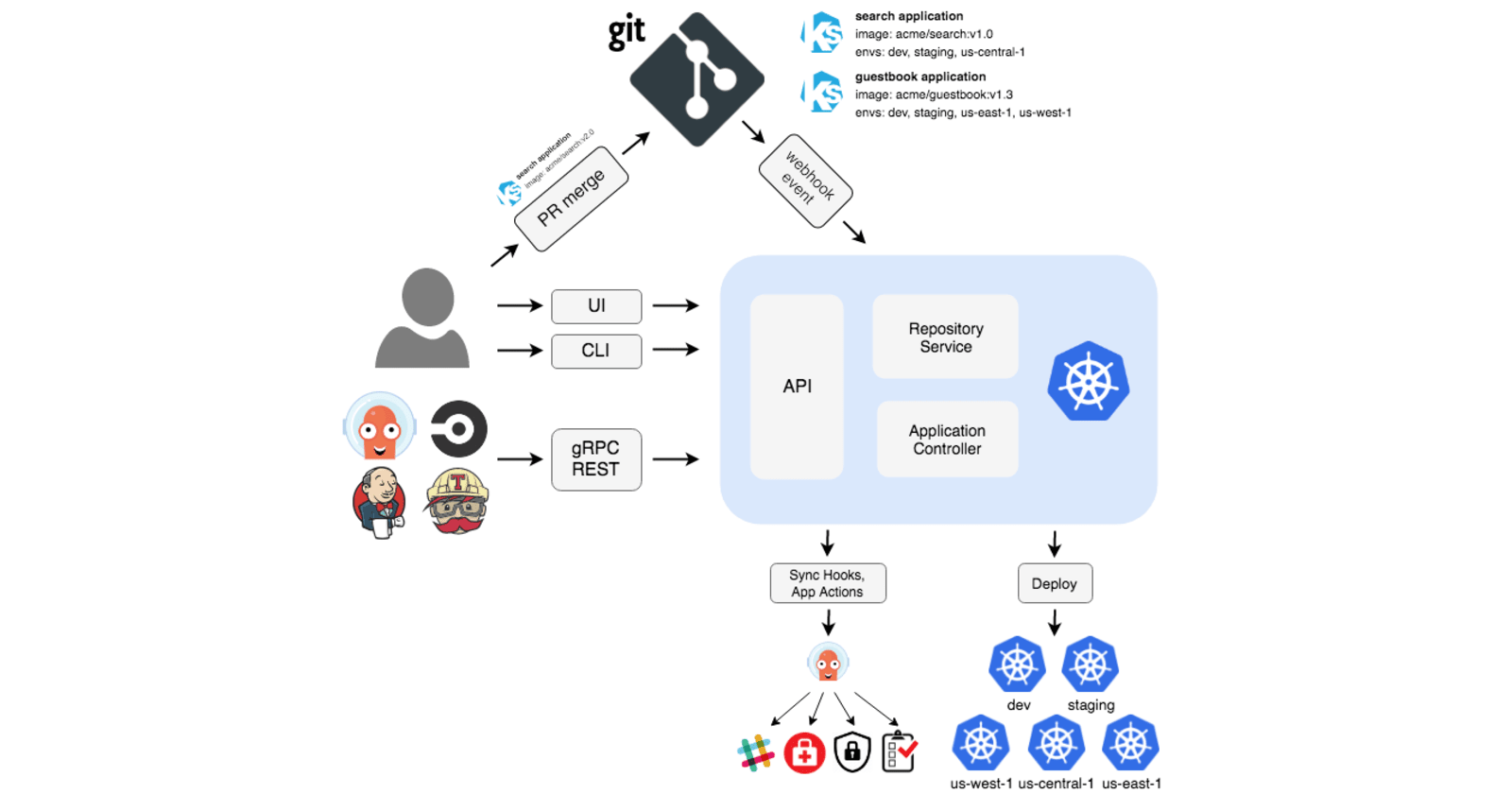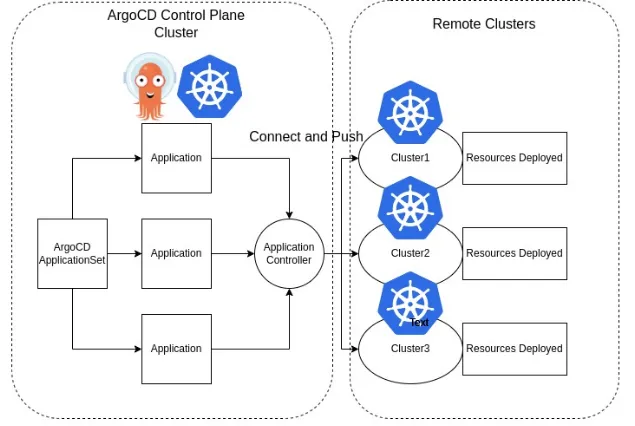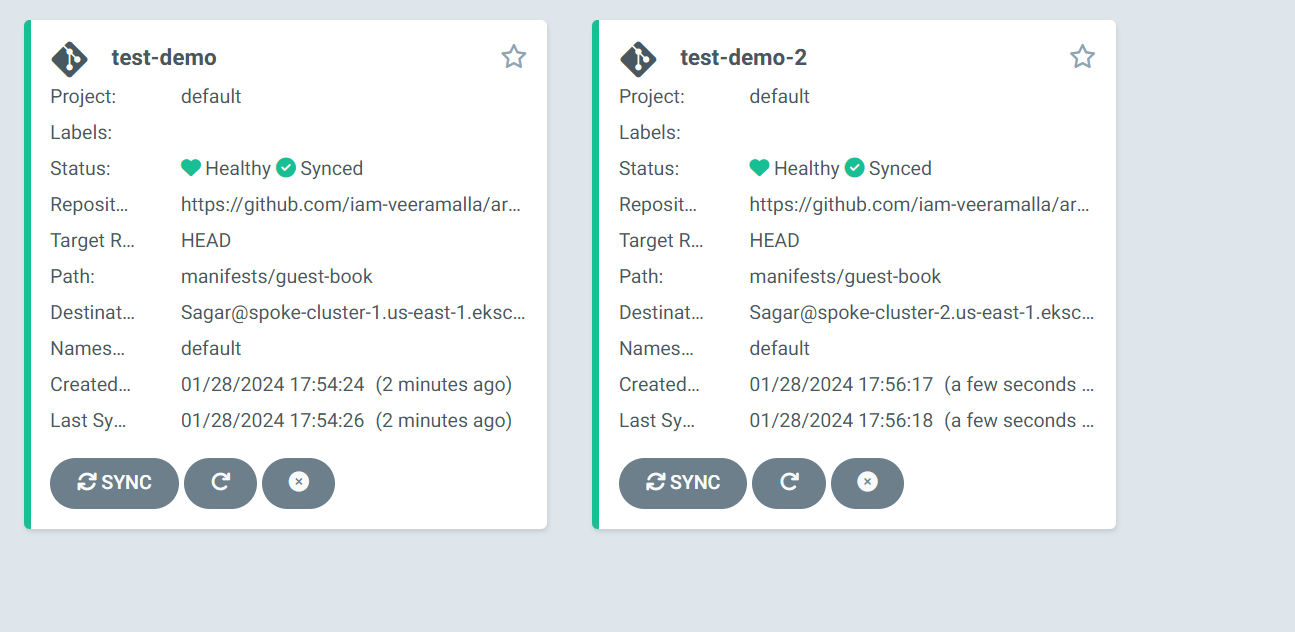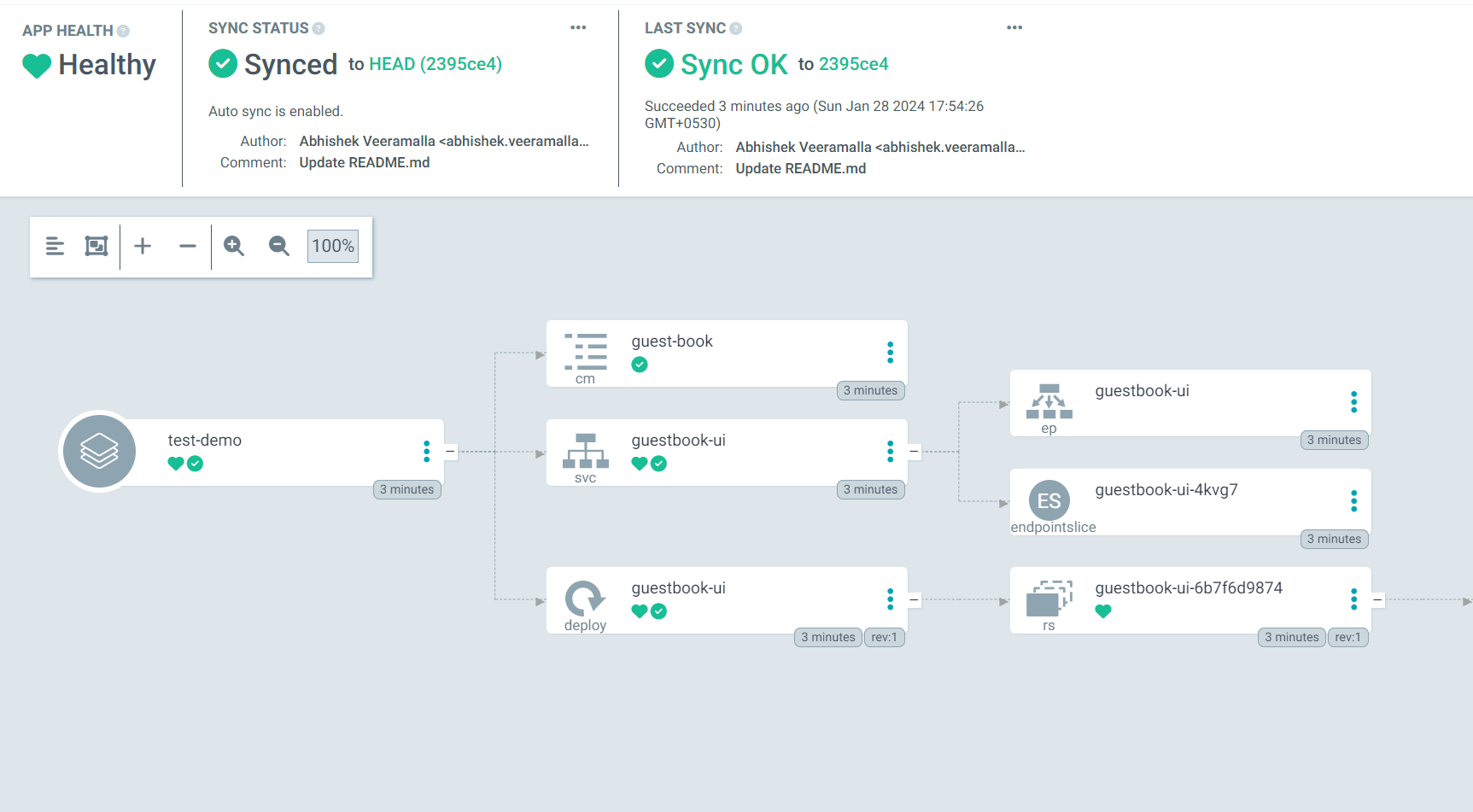MultiCluster Deployment In GiTOps
 Sagar Vashnav
Sagar Vashnav
In this demo, we are using the ArgoCd, ci-cd management Tool. While Deployment we are facing some issues like:
There is no special way to record the versioning in the Deployment Phase, if a developer or DevOps Engineer makes some changes in the Deployment Phase then it directly the infrastructure without Knowing. This causes the synchronization issue.
Solution -
They are taking Git as a Single Source of Truth, By adding the configuration and Infrastructure files into the GitHub. Changes made manually are automatically reverted now.
How did this happen?
In this Project, we are using the ArgoCd Hub-Spoke Model. In which there is one Standard Cluster that maintains the deployment in another Remote Cluster.

Pre-Requisites:
AWS CLI - (configure it before creating Cluster)
AWS eksctl
Kubectl - Command Line Tool
Create Clusters
In this project, we are creating 3 Clusters one - Hub Cluster and the other 2 Spoke Cluster. It takes some time, be patient.
eksctl create cluster --name hub-cluster --region us-east-1
eksctl create cluster --name spoke-cluster-1 --region us-east-1
eksctl create cluster --name spoke-cluster-2 --region us-east-1

Now check the Clusters, using
$ kubectl config get-contexts
CURRENT NAME CLUSTER
AUTHINFO NAMESPACE
Sagar@hub-cluster.us-east-1.eksctl.io hub-cluster.us-east-1.eksctl.io Sagar@hub-cluster.us-east-1.eksctl.io
Sagar@spoke-cluster-1.us-east-1.eksctl.io spoke-cluster-1.us-east-1.eksctl.io Sagar@spoke-cluster-1.us-east-1.eksctl.io
* Sagar@spoke-cluster-2.us-east-1.eksctl.io spoke-cluster-2.us-east-1.eksctl.io Sagar@spoke-cluster-2.us-east-1.eksctl.io
For checking the current Cluster:
$ kubectl config current-context
Sagar@hub-cluster.us-east-1.eksctl.io
For switching the clusters:
$ kubectl config use-context Sagar@hub-cluster.us-east-1.eksctl.io
Switched to context "Sagar@hub-cluster.us-east-1.eksctl.io".
Install Argo Cd to Hub Cluster
$ kubectl create namespace argocd
kubectl apply -n argocd -f https://raw.githubusercontent.com/argoproj/argoinstall.yaml
Check Pods for ArgoCd -
$ kubectl get pods -n argocd
NAME READY STATUS RESTARTS AGE
argocd-application-controller-0 1/1 Running 0 11m
argocd-applicationset-controller-dc5c4c965-2xvkc 1/1 Running 0 12m
argocd-dex-server-9769d6499-zv97w 1/1 Running 0 12m
argocd-notifications-controller-db4f975f8-mjfzv 1/1 Running 0 12m
argocd-redis-b5d6bf5f5-9jmnz 1/1 Running 0 12m
argocd-repo-server-579cdc7849-bvcws 1/1 Running 0 12m
argocd-server-557c4c6dff-hnhzm 1/1 Running 0 11m
Now, here comes the issue we have to make ArgoCd, use the HTTP mode (which means insecure way) by changing the Config Map File.
Let's find it and change it -
$ kubectl get cm -n argocd
NAME DATA AGE
argocd-cm 0 13m
argocd-cmd-params-cm 0 13m
argocd-gpg-keys-cm 0 13m
argocd-notifications-cm 0 13m
argocd-rbac-cm 0 13m
argocd-ssh-known-hosts-cm 1 13m
argocd-tls-certs-cm 0 13m
kube-root-ca.crt 1 13m
Edit the file by adding data: server.insecure: "true" at the end of configmap.
kubectl edit configmap argocd-cmd-params-cm -n argocd
### changes in the file
----------------
# Please edit the object below. Lines beginning with a '#' will be ignored,
# and an empty file will abort the edit. If an error occurs while saving this file will be
# reopened with the relevant failures.
#
apiVersion: v1
kind: ConfigMap
metadata:
annotations:
kubectl.kubernetes.io/last-applied-configuration: |
{"apiVersion":"v1","kind":"ConfigMap","metadata":{"annotations":{},"labels":{"app.kubernetes.io/name":"argocd-cmd-params-cm","app.kubernetes.io/part-of":"argocd"},"name":"argocd-cmd-params-cm","namespace":"argocd"}}
creationTimestamp: "2024-01-28T11:33:47Z"
labels:
app.kubernetes.io/name: argocd-cmd-params-cm
app.kubernetes.io/part-of: argocd
name: argocd-cmd-params-cm
namespace: argocd
resourceVersion: "4727"
uid: 8ba76b5c-8dba-4d9d-954d-ee8688860842
data:
server.insecure: "true"
------------------
Optional:
Checking in the deployment -
kubectl edit deploy/argocd-server -n argocd
#### find this in the deployment
- name: ARGOCD_SERVER_INSECURE
valueFrom:
configMapKeyRef:
key: server.insecure
name: argocd-cmd-params-cm
optional: true
Accessing the ArgoCd UI
To access the UI just change the cluster IP To Node Port -
kubectl edit svc argocd-server -n argocd
##### ClusterIp to NodePort
selector:
app.kubernetes.io/name: argocd-server
sessionAffinity: None
type: NodePort
You need a password to login to UI and CLI both so let's find it.
$ kubectl get secrets -n argocd
NAME TYPE DATA AGE
argocd-initial-admin-secret Opaque 1 35m
argocd-notifications-secret Opaque 0 36m
argocd-secret Opaque 5 36m
kubectl edit secret argocd-initial-admin-secret -n argocd
## copy the password
data:
password: Y3VKRVhwVlZzMEhORk5YeA==
This password is encrypted you have to decrypt it, and then you get the password.
$ echo Y3VKRVhwVlZzMEhORk5YeA== | base64 --decode
cuJEXpVVs0HNFNXx
Before log in, you have to find the port of Argocd-server svc.
$ kubectl get svc -n argocd
NAME TYPE CLUSTER-IP EXTERNAL-IP PORT(S) AGE
argocd-applicationset-controller ClusterIP 10.100.120.202 <none> 7000/TCP,8080/TCP 30m
argocd-dex-server ClusterIP 10.100.2.58 <none> 5556/TCP,5557/TCP,5558/TCP 30m
argocd-metrics ClusterIP 10.100.46.183 <none> 8082/TCP 30m
argocd-notifications-controller-metrics ClusterIP 10.100.148.168 <none> 9001/TCP 30m
argocd-redis ClusterIP 10.100.75.144 <none> 6379/TCP 30m
argocd-repo-server ClusterIP 10.100.99.219 <none> 8081/TCP,8084/TCP 30m
argocd-server NodePort 10.100.16.211 <none> 80:30220/TCP,443:32586/TCP 30m
argocd-server-metrics ClusterIP 10.100.76.128 <none> 8083/TCP 30m
you can find here the port is 30220 for HTTP. The ec2 IP is of any hub server.
* Allow the traffic on this port in AWS Security Group *
Link - http://{your hub ec2-ip}:30220
For CLI put - argocd login {your hub ec2-ip}:30220 // port
ex - argocd login 52.90.15.226:30220
Now Add the Clusters to ArgoCd using CLI
argocd cluster add {remote-cluster-name} --server {your hub ec2-ip}:PORT
ex - argocd cluster add Sagar@spoke-cluster-1.us-east-1.eksctl.io --server 52.90.15.226:30220
argocd cluster add Sagar@spoke-cluster-2.us-east-1.eksctl.io --server 52.90.15.226:30220
At this stage, all the setup of Argo Cd, and Kubernetes is done.
Deploy the Application
You can use this repo if you want to -
Deploy the application separately on both spoke clusters -

Deployed Applications -

Check the Deployment
Change to Spoke Cluster -
$ kubectl config use-context Sagar@spoke-cluster-1.us-east-1.eksctl.io
Switched to context "Sagar@spoke-cluster-1.us-east-1.eksctl.io".
Get the Deployment -
$ kubectl get all
NAME READY STATUS RESTARTS AGE
pod/guestbook-ui-6b7f6d9874-bgdwv 1/1 Running 0 5m9s
NAME TYPE CLUSTER-IP EXTERNAL-IP PORT(S) AGE
service/guestbook-ui ClusterIP 10.100.48.175 <none> 80/TCP 5m9s
service/kubernetes ClusterIP 10.100.0.1 <none> 443/TCP 67m
NAME READY UP-TO-DATE AVAILABLE AGE
deployment.apps/guestbook-ui 1/1 1 1 5m10s
NAME DESIRED CURRENT READY AGE
replicaset.apps/guestbook-ui-6b7f6d9874 1 1 1 5m10s
Delete The Cluster
As it's a costly setup, so delete the cluster when it deployed.
eksctl delete cluster --name hub-cluster --region us-east-1
eksctl delete cluster --name spoke-cluster-1 --region us-east-1
eksctl delete cluster --name spoke-cluster-2 --region us-east-1
Thanks for your time......
Subscribe to my newsletter
Read articles from Sagar Vashnav directly inside your inbox. Subscribe to the newsletter, and don't miss out.
Written by

Sagar Vashnav
Sagar Vashnav
I am a developer who loves to explore new technology and is always ready to adopt new technologies.